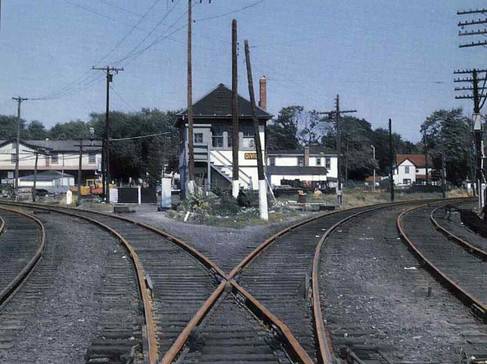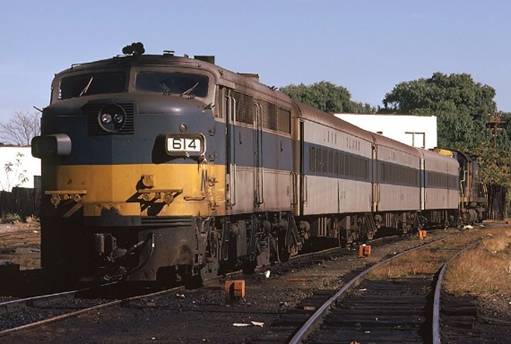Two Worlds
As its LIRR tower proclaims, Hicksville is the point at which the central line of the railroad divides in two. "Port Jefferson" and "Ronkonkoma" trains (to use the common, if unofficial, names for their respective branches) are on separate tracks east of DIVIDE tower, but they share the Main Line west of it.
Divide Tower before grade crossing elimination
http://www.lirrhistory.com/dec2003/divide.JPG
The tale of the storm highlights the "Have / Have Not" differences which existed in the 1970s between these branches. In those years, if you lived in, say, Huntington, you were blessed with electrification and the new trains that came with it. The fact that the M1 equipment would develop some very real operational problems does not diminish the fact that, in general, electrification had substantially improved the quality of passenger service on the line. If you were stuck in an M1 car during the Ground Hog Day storm of 1976, you still had heat, air circulated by a modern ventilation system, working restrooms, and if you were seated, a comfortable seat.
It is understandable that financial resources were not available for the railroad to improve and electrify Ronkonkoma service at the same time as Port Jefferson service. What is not understandable, however, is that the quality of commuter service on the Ronkonkoma branch had been permitted to substantially deteriorate in the years leading up to that time, and that adequate steps were not taken to maintain minimum service standards, even when things became dire.
*
In the early 1970s, it was still true that much of the diesel passenger car fleet had begun its service as part of the steam passenger fleet. A small part of it had been built in the 1960s; and a large part of it dated from the 1950s. Many of these cars had to some degree been upgraded (e.g., acrylic windows been replaced the original safety glass, to better resist vandalism). The remainder of the fleet - and until 1974, this remainder was a significant minority of it - dated from the 1930s and the late 1920s. These cars had gone through rebuilding programs some years before, but the oldest among them remained primitive, especially in terms of restroom facilities.
Things came to a head (no pun intended) in 1974, when part of a 1920s coach suffered a structural failure, causing a minor crash. Damage was not serious, but the implications were - all of the remaining 1920s coaches had to be withdrawn from service immediately and scrapped.
The railroad had to scramble, desperately trying to pick up surplus commuter coaches from other railroads, but good coaches were not easy to come by. If it found a car that had seats, would not suffer structural failure, would roll safely on the track, and had operating brakes, it was worth acquiring, and it was put into service as soon as possible. Note that compatibility with LIRR electrical standards for power to be used for lighting, fans, and heating were not mandatory. Thus, on dark winter evenings in 1976, I often rode home in a coach that had neither lights nor heat. For a while, the regular Trainman wore a miner's helmet, with a light that let him see the tickets he was punching (he later switched to carrying a flashlight).
*
The above explains why some cars never had heat. But why, during the ice storm, would an entire train of coaches lose power all at once?
Railroads use different methods to generate "hotel power" (i.e., electricity appropriate for lighting, heat, and air conditioning) for passengers cars. In the 1970s, most commuter railroads in North America, including the LIRR, took the same approach, which was easily recognizable. From the outside, their commuter trains appeared to have two unmatched diesel locomotives, one at each end.

LIRR Power Car 614, purchased as a used Alco FA-2 locomotive
from the Burlington Northern Railroad; the newer diesel engine at
the other end of the train actually pushes or pulls it.
https://www.pinterest.ca/pin/659707045388146893/
© George W. Hamlin
In reality, one of the apparent locomotives no longer functioned as one. Typically, it was very old, and it had been acquired second- or third-hand after decades of service. It then was rebuilt into something called a "Power Car." An engineer could drive a train from a Power Car, because its controls were connected electronically to the real locomotive at the train's other end. The Power Car's other purpose was to generate hotel power for the train. The old combustion engine inside it was no longer connected to its wheels, so it could not move the train (or even the Power Car itself); it simply generated electricity.
So, what went wrong on February 2? The trains for the morning rush hour had spent the night out east. Their Power Cars had only enough fuel in their tanks to handle their morning rush-hour assignments; after that, they would be refueled in Queens. But when a 90-minute run from, say, Ronkonkoma to Hunterspoint turned into a 5-hour run, they ran out of fuel. The real locomotives had plenty of fuel to move the trains - but they did not have the generators needed to create hotel power. Poof! No more heating and lights.
*
So, many, many commuters suffered on the day of the ice storm, but some of those who lived on the diesel branches suffered more.
Although I normally feel an attachment for the place in which I grew up, I do not have many fond memories about having to hover over Hicksville for all those cold hours.
***

